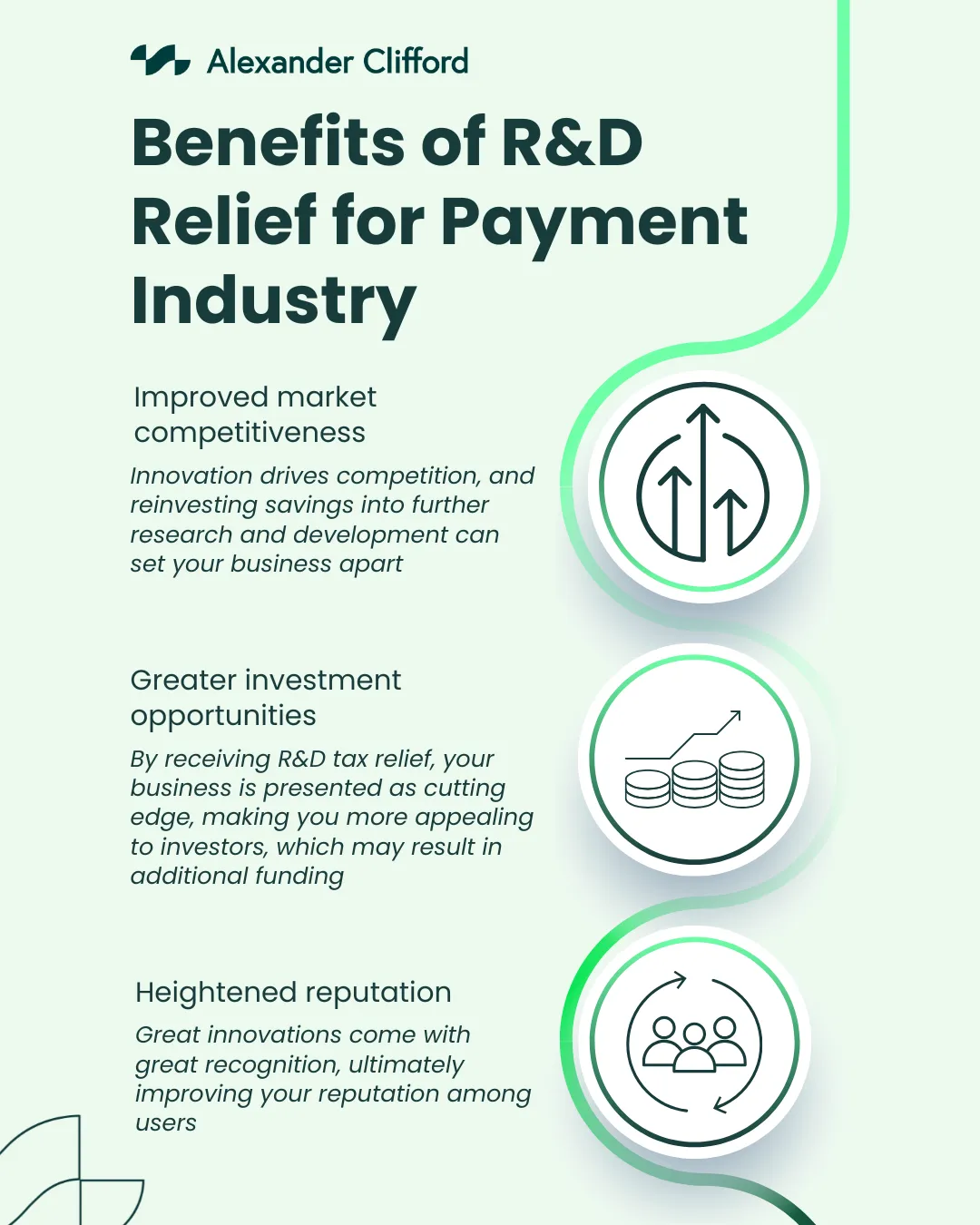Is Your Electronic Payment System Eligible for R&D Tax Relief?

The time of cash is over thanks to electronic payment technology system advancements, but do HMRC recognise innovation in electronic payment systems as qualifying research and development?
We examine the world of financial technology, from the latest advancements to future innovation trends, to reveal the truth about whether your electronic payment system is eligible for the UK’s R&D tax relief.
As the world adopts a more digital way of living, the demand for electronic payment systems has been exceptionally high. This has led to fast paced innovation ranging from biometric security to voice commanded payments.
With businesses pouring time and money into improving electronic payment systems, we’re on a mission to help them receive a return on their investment with R&D tax relief – the innovation fund that supports advancement in science and technology.
So let’s determine whether your electronic payment system (EPS ) qualifies.
What is an Electronic Payment System?
An electronic payment system (EPS) is an alternative payment method to cash transactions, and operates by digitally transferring funds.
Although EPS technology was first introduced when Visa unveiled the first credit card terminal in 1979, it took a while for industry leaders to invest in innovative advancement in EPS’s.
Following the B2B boom in electronic transactions in the early 1980s, here is a brief timeline of EPS advancement:
- 1994: Launch of online payment capabilities
Visa successfully make the first online payment, and First Virtual Holdings launches an online payment system for online credit card transactions - 1999: Online transactions made more secure
The launch of Paypal allowed consumers to make online purchases without sharing their credit card information with businesses - 2007: Contactless transactions are introduced
Near field communication technology set the stage for contactless payments, and Barclays released the first contactless card in the UK - 2011: Mobile payments made possible
With Quickpay and Google wallet launches, consumers are able to make wireless transactions via their mobile phones - 2012: Launch of wearable payment technology
Barclaycard releases the PayBand, a wristband that allows consumers to pay without the use of card, cash or phone, paving the way for further wearable technology integration
For a deeper exploration into the evolution of payment systems from traditional to digital, read our blog: From Analog to Digital: A Deep Dive into Payment Systems
The fact that advancement in EPSs really started to make waves after 1999 is a testament to how the internet has influenced the way we pay.
Book a quick call back
Innovation in Electronic Payment Systems
Innovation in Electronic Payment Systems has driven significant advancements in digital transactions, enabling businesses and consumers to embrace cashless payments seamlessly. With constant developments in fintech innovation, these systems now cater to diverse needs, offering enhanced security, speed, and convenience. As organisations explore new ways to streamline processes, the adoption of advanced payment technologies has surged.
Back in 2020, a large portion of the world went cash free for the first time. With more people relying on EPSs than ever before and the limitations on contactless transactions removed, opportunities for further innovation were revealed.
Some of the current key areas of innovation for electronic payment systems include:
- Enhanced security: The development of fraud detection algorithms, encryption protocols and blockchain based solutions, aim to protect EPS users and their data.
- Improvements in user experience: By frequently updating contactless payment solutions and incorporating them with seamless app development and technology integrations, EPSs are made more accessible.
- Speed and scalability: By developing new systems capable of handling high volumes of transactions with minimal speed, EPS transactions are made more efficient.
With enhanced focus on these areas of innovation, the way we use EPSs has transformed over recent years.
Combining convenience with easy tracking, biometric authentication and automated transaction notifications have quickly become the key to managing our everyday expenditures – but this kind of advancement takes a lot of trial and error throughout significant research and development phases.
Introduction to R&D Tax Relief
The R&D tax relief (also known as R&D tax credits) is a government fund that incentivises businesses to invest in research and development.
Its aim?
To reduce the costs of scientific and technological innovation, and in turn, inspire an advancement in knowledge that helps to position the UK as a leader in innovation.
R&D Tax Relief Eligibility
As per HMRC’s guidelines, research and development is defined as a project that seeks to overcome a technical uncertainty in the field of science or technology, that a competent professional in the field could not solve. The project must also aim to produce a new or improved:
- Product
- Software
- Service
- Process
While the R&D tax relief provides qualifying projects with a quick return on investment, only a portion of the costs associated with research and development may qualify for the tax credits. Qualifying costs include:
- Direct staff costs (including PAYE, NIC and pension contributions)
- Software costs
- Prototype development costs
- Consumable items (including materials and some utilities)
As this is a form of tax relief, businesses looking to claim R&D tax credits must also be liable to corporation tax.
Benefits of R&D Tax Relief for the Payment Industry
For businesses in the payment industry, R&D tax relief can be incredibly lucrative. By reducing the cost of research and development, the relief plays an active role in fuelling innovation – which can lead to a whole array of additional benefits, including:

On top of direct benefits for your business, your innovations strengthen the economy, and help to position the UK as a leader in financial technology (fintech). This efficient way of supporting businesses that take on challenging projects, while providing an economic boost, is why R&D tax relief is a reliable source of innovation funding.
Is Your Electronic Payment System Eligible for R&D Tax Relief?
Research and development projects that focus on producing or enhancing electronic payment systems typically fall under the category of technological innovation. By default, this means that you’re already half way to qualifying for R&D tax relief!
You next need to address the technical uncertainty that your EPS project aims to overcome, and what is required to solve the problem. You can do this by answering each of the following questions:
- Is there a lack of solution or existing knowledge to the problem you’re aiming to solve with your project?
- Is a competent professional in the field unable to solve the problem?
- Is research and development necessary to solving the problem?
If you confidently said yes to each of these questions, then your project may be eligible for R&D tax credit relief.
Before you jump into making a claim, it is recommended that you consult with an R&D tax credit advisor, as they have a deeper understanding of the criteria that your project must meet in order to qualify.
How to Maximise R&D Tax Relief for Payment Systems
To maximise your R&D claim is to take a strategic approach to identifying qualifying activities and costs in order to make the most of the relief while maintaining compliance with tax regulations.
The best way to maximise your R&D tax relief requires following a simple plan that may also coincide with your project mapping phase. Your R&D tax relief plan should look like this:
- Keep up to date with HMRC’s R&D policy
Being aware of changes to policy or guidelines can help ensure your project remains eligible for the relief - Strategically allocate funding
If you have additional research and development funding such as grants, allocating these finances to costs that aren’t eligible for R&D tax relief can help to reduce expenditure and increase tax credits - Document each stage of the project
By keeping detailed documents of each stage (including challenges you face in the project), you’ll be able to identify qualifying activities - Categorise your costs
Keeping your research and development costs separate from daily operations costs can make identifying your eligible expenditure easier, especially if you categorise each of the costs involved in the project - Work with R&D tax credit advisors
People specialising in R&D tax relief have a working knowledge of R&D compliance, and are therefore able to assist in producing a well rounded claim that adheres to the latest tax regulations
How Alexander Clifford Can Help
At Alexander Clifford, we pride ourselves on being one of the UK’s leading R&D tax credit advisories. Our team has in depth insights into the latest R&D policies and legislation, ensuring you’re always in safe hands.
We’re meticulous when it comes to uncovering qualifying activities and eligible expenses that others might overlook, helping you receive the full potential of your R&D tax credit claims.
With over 2,400 successful claims and counting, our track record speaks for itself.
That’s why businesses trust Alexander Clifford to deliver expert advice and exceptional results when it comes to R&D tax credits.
Ready to experience our 5-star service? Simply fill in the form below to get started, or click here to book an appointment with one of our specialist advisors today!
Get a decision on your R&D eligibility from a qualified specialist in 15 minutes.







